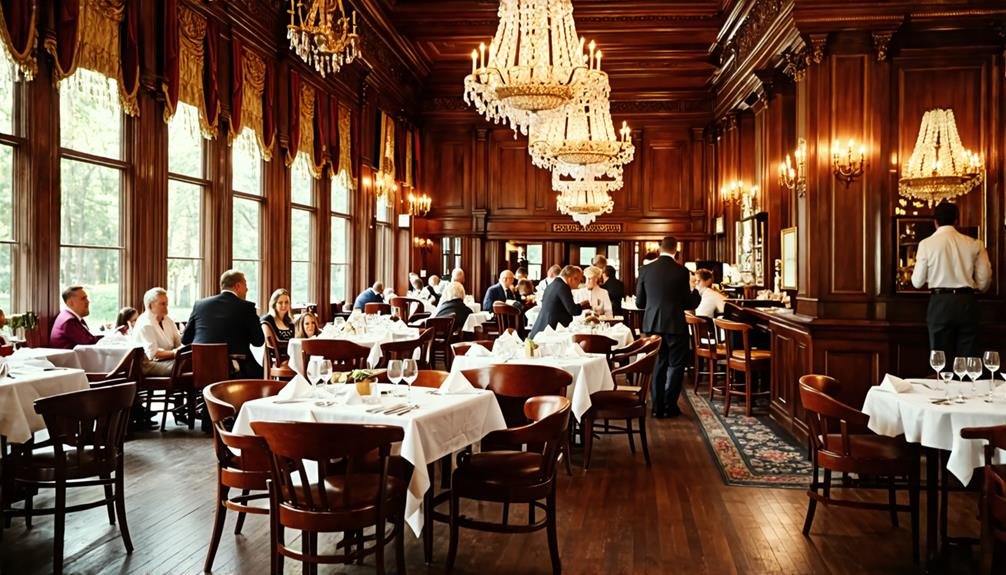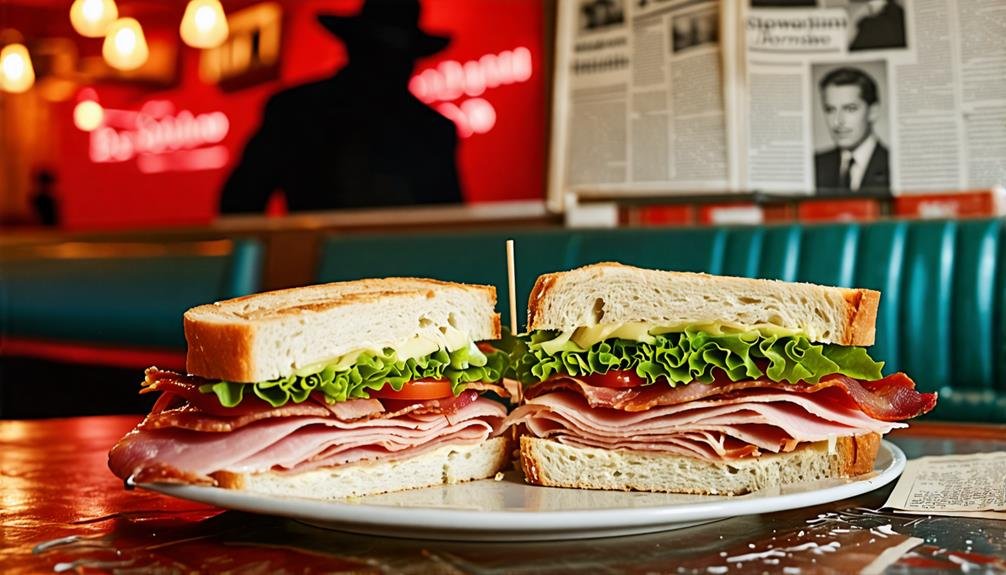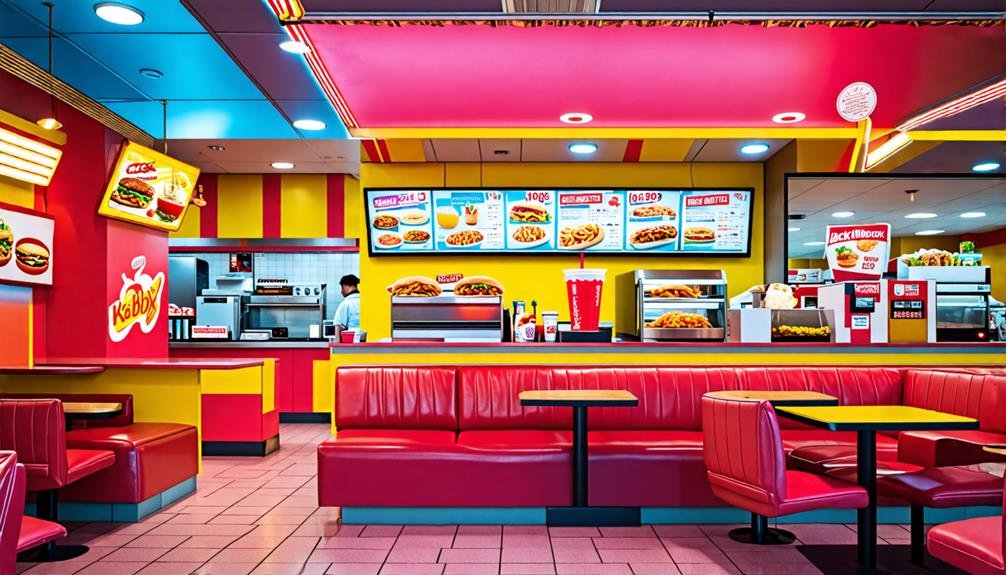The club sandwich is a quintessential American classic with intriguing origins. Both the Union Club of New York City and the Saratoga Club House assert they created this delightful dish, with the Saratoga claiming the title in 1894. However, evidence supporting their claim is shaky, making the Union Club a strong contender. This multi-layered marvel symbolizes a prosperous era in American eating culture. Its enduring popularity showcases its appeal, inviting chefs to discover innovative variations. The club sandwich not only delights taste buds but also connects us through a shared love of good food. Find out more about its fascinating venture!
Historical Origins of the Club Sandwich
The club sandwich's origins are rich in culinary history, with two prominent venues—the Union Club in New York City and the Saratoga Club House—each vying for the title of its creator in the late 1800s. This rivalry adds a fascinating dimension to the narrative of the sandwich, as the club sandwich transcends mere ingredients to symbolize American culture and cuisine.
The Union Club claims that its establishment was the first to serve this iconic American dish, featuring layers of turkey or chicken, crispy bacon, and fresh greens. On the other hand, the Saratoga Club House contends that its chefs were the innovators behind this delightful meal, utilizing similar components but presenting them in a distinct manner.
Although the precise beginnings may remain elusive, the club sandwich has transformed into a cherished favorite that caters to a wide range of tastes. The blend of flavorful poultry, smoky bacon, and crunchy vegetables nestled between toasted slices of bread has enchanted diners for decades. By exploring the evolution of this classic dish, we honor not only its delicious profile but also its esteemed status in the landscape of American gastronomy.
The Union Club of New York City
Where did the club sandwich originally gain prominence? The Union Club of New York City is recognized as a significant contributor to the sandwich's rich narrative, with various reports attributing its creation to the club's culinary team. Established in 1836, the club has served as a meeting place for prominent individuals, making it an appropriate setting for the emergence of this classic dish.
Several accounts emphasize the Union Club's role in the sandwich's heritage:
- Historical Importance: The club's dining area has welcomed influential political and social leaders throughout its history.
- Culinary Advancement: In 1889, an unnamed chef at the club was noted for creating a chicken sandwich, signifying an important moment in culinary evolution.
- Ely Goddard's Contribution: In 1893, Goddard was acknowledged for popularizing sliced chicken sandwiches, further strengthening the Union Club's association with the dish.
The Union Club exemplifies the lasting allure of the club sandwich, a meal that represents both heritage and luxury.
The Saratoga Club House Claim

The Saratoga Club House in Saratoga Springs, New York, claims to be the birthplace of the club sandwich. The establishment asserts that its culinary team introduced this iconic dish to patrons in 1894. Nestled in the heart of a vibrant resort town, the Saratoga Club House attributes the creation of the sandwich to either Richard Canfield, the club's founder, or the skilled chefs in its kitchen.
Despite the Saratoga Club House's intriguing story, the evidence backing this claim is sparse. The lack of definitive historical records raises doubts about the authenticity of its origin narrative. In the broader context of culinary history, the Union Club of New York City, with its more extensive documentation, presents a stronger case for being the true originator of the sandwich.
Nevertheless, the charm of the Saratoga Club House endures, attracting food enthusiasts and curious diners. Regardless of one's stance on its claim, the club sandwich has established itself as a cherished staple in American cuisine. The ongoing debate about its origins continues to spark passion and intrigue among culinary explorers, reminding us that food often carries rich, flavorful histories.
Myths Surrounding the Club Sandwich
The club sandwich has inspired a variety of myths, the most notable being the incorrect acronym 'Chicken and Lettuce Under Bacon.' This fanciful idea has been disproven by fact-checking platforms like Snopes, which reveal a more intriguing history. The club sandwich originated as a finger food in a prestigious clubhouse, intended to satisfy the refined tastes of its members.
Here are some fascinating details about this beloved dish:
- The club sandwich likely emerged in the late 1800s, flourishing in social establishments.
- Its multi-layered form not only appeals visually; it symbolizes a prosperous era.
- Chefs often experiment with variations, incorporating unique ingredients like avocado or zesty sauces.
As we dive into the myths surrounding the club sandwich, it becomes evident that this culinary delight represents more than just a meal; it embodies social connections and culinary creativity. Each bite narrates a tale of heritage and innovation.
The Legacy of the Club Sandwich
The club sandwich's lasting appeal has cemented its place as a classic American dish, known for its satisfying layers of flavors and textures. This towering meal, typically stacked with tender turkey, flavorful ham, and crispy bacon, creates a delightful tasting experience. Creamy mayonnaise, crisp lettuce, and ripe tomato offer a refreshing contrast, all enveloped by toasted bread that provides a pleasing crunch.
Throughout the years, the club sandwich has transformed, with contemporary versions featuring triple-deckers that include an additional slice of bread, catering to varying appetites. Its adaptability makes it a preferred choice for any meal, whether enjoyed at a local diner or an upscale bistro.
The allure of the club sandwich lies not only in its taste but also in its capacity to unite people through a mutual appreciation for quality cuisine. As patrons relish each bite, they engage in a rich legacy that spans generations. The club sandwich stands as a testament to culinary innovation, embodying the essence of freedom and enjoyment that characterizes American dining culture. Its legacy persists, promising delight for many more years ahead.
The Club Sandwich in Modern Times
In modern times, the club sandwich has evolved into a versatile favorite found on menus across a wide array of restaurants. From classic versions featuring traditional ingredients to creative adaptations that include gourmet toppings, the sandwich continues to capture the hearts—and appetites—of diners everywhere. Its enduring popularity is a proof of its satisfying combination of flavors and textures, making it a go-to choice for a quick bite or a leisurely meal.
Variations Across Restaurants
Club sandwiches have undergone remarkable transformations in contemporary dining, presenting a variety of ingredients and methods that reflect local flavors and creative techniques. This timeless sandwich has transcended its classic formulation, becoming a platform for culinary innovation embraced by both chefs and home cooks.
Explore these exciting interpretations:
- Mediterranean Club: This version includes roasted bell peppers, tangy feta, and a splash of premium olive oil, evoking the vibrant essence of the Mediterranean coast.
- Spicy Southwest Club: Packed with zesty jalapeños, creamy guacamole, and smoky chipotle mayonnaise, this rendition delivers a fiery explosion of flavor.
- Veggie Delight Club: A healthful option featuring layers of char-grilled vegetables, smooth hummus, and ripe avocado, catering to the preferences of plant-based eaters.
These inventive takes on the classic highlight the sandwich's adaptability and its capacity to meet a wide range of dietary needs. The club sandwich remains a beloved fixture in today's cuisine, inviting culinary enthusiasts to explore and savor new tastes while honoring its rich legacy. Whether in its traditional form or a modern twist, the club sandwich continues to captivate food lovers everywhere.
Popularity in Diners
The club sandwich is a widely cherished dish in American diners, known for its versatility and satisfying layers. This classic meal allows diners to personalize their experience, incorporating ingredients like turkey from Butterball, crispy bacon from Oscar Mayer, and fresh vegetables from local farms. The club sandwich appeals to a wide range of tastes, making it a favorite across various demographics.
As diners adapt to contemporary culinary trends, the club sandwich has transformed, featuring modern additions such as spicy aioli from Sir Kensington's or creamy avocado slices. Whether enjoyed as a traditional triple-decker or with inventive toppings, the combination of textures and flavors keeps it relevant in the fast-paced food scene.
The enduring popularity of the club sandwich also stems from its status as a comfort food, invoking nostalgia for many. It serves not just as a meal, but as a shared experience among friends and family, filled with laughter and conversation in the inviting atmosphere of diners like Denny's or IHOP. Thus, the club sandwich remains a quintessential American classic, inviting everyone to delight in its delicious layers.
Unsolved Mysteries of Its Birth

The true origin of the club sandwich remains an intriguing mystery. The Union Club of New York City and the Saratoga Club House both claim to have created this iconic dish. This culinary enigma is steeped in history, yet definitive evidence continues to elude researchers.
- The Union Club cites earlier mentions of the sandwich, with references dating back to 1889, linking it to Ely Goddard.
- The Saratoga Club House counters with its claim, showcasing the club sandwich on its menu starting in 1894.
- Richard Canfield is often associated with the Saratoga claim, but the absence of solid documentation undermines its credibility.
The lack of irrefutable proof adds to the allure of the club sandwich's story, allowing food enthusiasts to celebrate its legendary status. Unlike other culinary origins laden with controversy, the tale of the club sandwich fosters a sense of camaraderie and shared enjoyment, reminding us that some mysteries are best savored rather than unraveled.
Impact on American Cuisine
The Union Club of New York City and the Saratoga Club House have significantly shaped the enduring legacy of the club sandwich, profoundly impacting American cuisine with their unique takes and rich histories. The club sandwich, featuring layers of turkey, ham, bacon, and fresh vegetables, is more than just a meal; it encapsulates the essence of culinary creativity and social interactions that characterize American dining culture.
This iconic sandwich has gone beyond its initial creation, becoming a beloved item on the menus of diners and high-end eateries alike. Its adaptability allows for countless modifications, catering to a wide array of tastes and dietary needs. Whether served as a quick midday meal or a hearty dinner option, the club sandwich represents comfort and indulgence.
Furthermore, the sandwich's widespread availability across the United States showcases the rich tapestry of American cuisine, blending flavors and culinary traditions from various regions. Its continued popularity ignites culinary innovation in kitchens, encouraging chefs to play with ingredients while respecting its traditional roots. Each bite not only delivers flavor but also represents a slice of culinary history that celebrates freedom, diversity, and the pleasure of sharing meals with family and friends.









